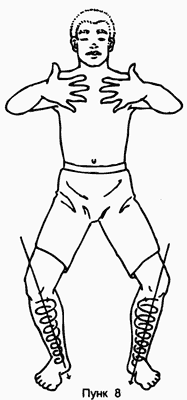The next step in the rooting practice involves the ankles and knees. The exercise itself is not difficult, like most Taoist practices. However, when performing an exercise, there is more going on than can be seen with the naked eye. Standing firmly on all nine points, you begin to slowly move your ankles outward. In fact, the process of “rooting” consists of two stages. First you “put down roots into the earth”, then you “draw in” earthly energy. This week we'll focus on the first step. The main goal is to transfer body weight to the ground.
As you begin to move your ankles, imagine that your legs have become screws that are literally screwed into the ground. The process of “screwing in” is accompanied by energy directed along the outer surface of the legs to the heels, from the heels to the toes, from the toes to the foot. In the right leg the energy flow moves clockwise, in the left leg it moves counterclockwise.
To enhance the feeling of “screwing in”, you should spread your knees to the sides as far as possible. Movements must be smooth, otherwise you may injure yourself. Raising the knees opens the groin area (“gua”), the muscles of which are often tense, causing pain.
Sometimes you can notice a disproportion in the development of the muscles on the right and left sides of the body. It is recommended to eliminate it using the “rooting” exercise. If you did everything correctly, then your pose will resemble the horseman's pose, which is called that in qigong practice.
“Rooting” exercises are the basis of the fundamentals of Qigong and Tai Chi Chuan practices. As in other similar cases, the concepts of Qigong and Tai Chi Chuan are difficult for people with a Western mindset to grasp. And yet, following the recommendations, you can easily cope with this task, provided that you exercise regularly. As you spread your ankles and knees out to the sides, squat slightly, this will increase the pressure on all nine points. Create a clear mental picture of your feet “screwing” into the ground and you will feel an energetic connection between your knees, ankles and heels.

By doing this exercise you will activate your ligaments, tendons, calves and hip muscles. It is the tendons and ligaments that actively work when squatting and turning the legs. Previously, I taught you to tense the back muscles of your legs, which gives stability to the pose. “Rooting” exercises relieve muscle tension, with the main load falling on the tendons. This is one of the paradoxes of the practice of “rooting”. The better you master it, the faster your muscles can relax. However, do not forget that mastery requires diligent training.
1. Take any “two-sided” static pose. Feet are parallel to each other, shoulders are turned.
2. Alternately or simultaneously, press the nine points on your feet to the floor.
3. Spread your ankles slightly apart. The movement should be smooth. In fact, the ability to move your ankles is quite limited.
4. Feel the pressure of your body weight on your heels and mentally “screw” your feet into the ground. In the right leg the energy flow moves clockwise, in the left leg it moves counterclockwise.
5. Spread your knees all the way. Do not exert significant muscular effort. Raising the knees opens the groin area (“gua”).
6. Bend your knees slightly, tighten your sacrum. The back is straight. Make sure that your kneecaps do not extend beyond your toes.
7. Feel the tendons of your legs “twist” in the same direction as the spiral energy flow penetrating into the earth. In the right leg the energy flow moves clockwise, in the left leg it moves counterclockwise.
8. Imagine how the energy of the legs is “screwed” into the ground. In the right leg the energy moves clockwise, in the left leg it moves counterclockwise.
9. Relax your muscles as much as possible, allowing the tendons to take over the body's energy.
10. Feel your heels pressing into the ground with the help of your knees and ankles.
11. Practice the exercise in a static position every day for five minutes.
12. Addition: try to “breathe” through the babbling brook points while performing the “reverse breathing” exercise.
Next week I will tell you the rest of the details related to the rooting practice. For a long time it was available only to a select few. You have a week ahead to master the basics, without which you will not be able to move forward. The author learned about most of the exercises described on these pages from his teachers, who rarely put pen to paper or never put their knowledge on paper at all.



